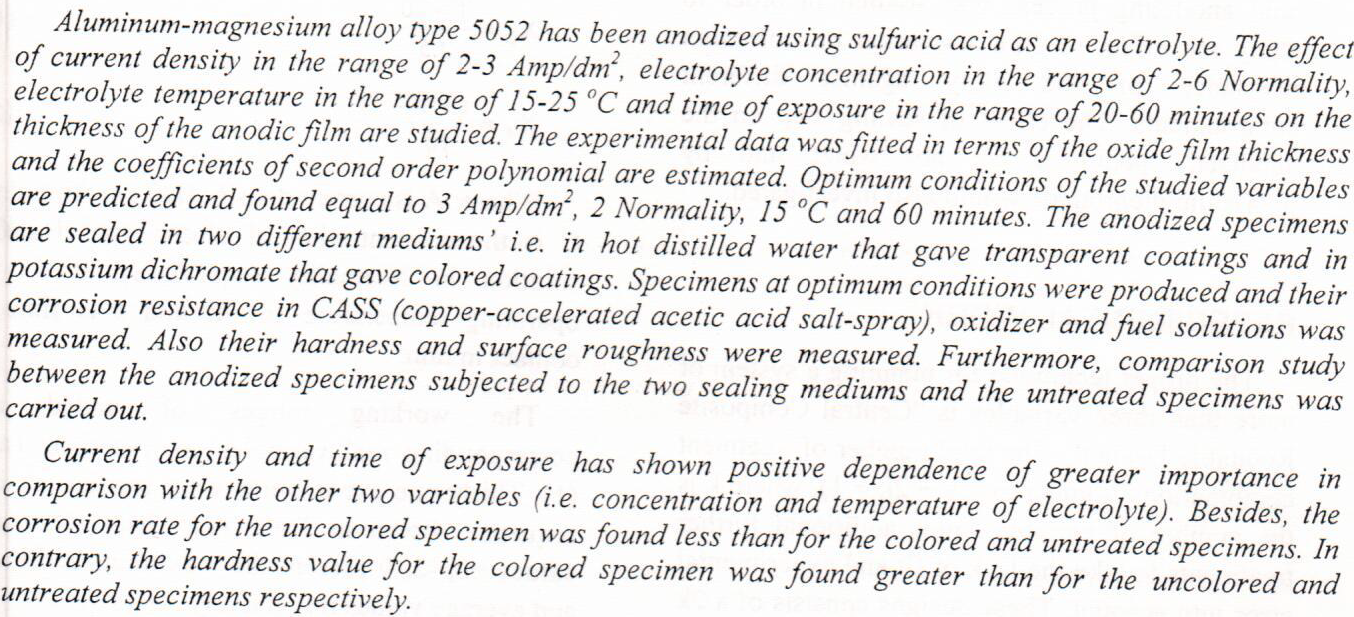
The (NiTsPc) thin films operating by vacuum evaporation technique are high recital and good desirable for number of applications, were dumped on glass substrates at room temperature with (200±20nm) thickness and doped with Al at different percentage (0.01,0.03) besides annealing the sample with 200˚C for 1 hours . The stimuluses of aluminum dopant percentage on characterization of the dropped (Ni Ts Pc) thin films were studied through X-ray diffraction in addition from the attained results, were all the films have polycrystalline in nature, as well the fallouts of XRD aimed at film illustrations polycrystalline, depending on the Al ratio doping, the results, SEM exposed the surface is regularly homogeneous. Utilizing first-ideolog
... Show More (5)
(5)
 (5)
(5)
The present work aims to study the efficiency of using aluminum refuse, which is available locally (after dissolving it in sodium hydroxide), with different coagulants like alum [Al2 (SO4)3.18H2O], Ferric chloride FeCl3 and polyaluminum chloride (PACl) to improve the quality of water. The results showed that using this coagulant in the flocculation process gave high results in the removal of turbidity as well as improving the quality of water by precipitating a great deal of ions causing hardness. From the experimental results of the Jar test, the optimum alum dosages are (25, 50 and 70 ppm), ferric chloride dosages are (15, 40 and 60 ppm) and polyaluminum chloride dosages were (10, 35 and 55 ppm) for initial water turbidity (100, 500 an
... Show MoreNew complexes of Al(III) such as [Al (Ura) (Phen) (OH2) Cl ] Cl. 2H2O, [Al(Ura)2(OA)(OH2)Cl].H2O and [Al(Ura)3Cl3]H2O type, where (Ura)=Uracil, (Phen)= 1,10-Phenanthroline monohydrate and (OA)= Oxalic acid dihydrate, were prepared. The elemental microanalysis, FT.IR, electronic spectra, and magnetic susceptibility as well as the conductivity measurements are characterized. For isolated three complexes for six coordinated of Al(III) are proposed with molecular formulas that depend on the nature of (Ura), (Phen) and (OA) present. The suggested molecular structure into all complexes for aluminum ion is octahedral geometries .The antibacterial efficacy was examined from metal salt (AlCl3), ligands and metal complexes into the pathogenic bacteri
... Show MoreIn this work, yttrium oxide particles (powder) reinforced AL-Si matrix composites (Y2O3/Al-Si) and Chromium oxide particles reinforced AL-Si matrix composites (Cr2O3/AL-Si) were prepared by direct squeeze casting. The volume percentages of yttrium oxide used are (4, 8.1, 12.1, 16.1 vol %) and the volume percentages of the chromium oxide particles used are (3.1, 6.3, 9.4, 12.5 vol. %). The parameters affecting the preparation of Y2O3/Al-Si and Cr2O3/AL-Si composites by direct squeeze casting process were studied. The molten Al-Si alloy with yttrium oxide particles or with chromium oxide particles was stirred again using an electrical stirrer at speed 500 rpm and the molten alloy was poured into the squeeze die cavity. Th
... Show More (1)
(1)
 (1)
(1)
Oil well drilling fluid rheology, lubricity, swelling, and fluid loss control are all critical factors to take into account before beginning the hole's construction. Drilling fluids can be made smoother, more cost-effective, and more efficient by investigating and evaluating the effects of various nanoparticles including aluminum oxide (Al2O3) and iron oxide (Fe2O3) on their performance. A drilling fluid's performance can be assessed by comparing its baseline characteristics to those of nanoparticle (NPs) enhanced fluids. It was found that the drilling mud contained NPs in concentrations of 0,0.25, 0. 5, 0.75 and 1 g. According to the results, when drilling fluid was used without NPs, the coeff
... Show More (2)
(2)
Sn effect on the phase transformation behavior, microstructure, and micro hardness of equiatomic Ni-Ti shape memory alloy was studied. NiTi and NiTiSn alloys were produced using vacuum induction melting process with alloys composition (50% at. Ni, 50% at.Ti) and (Ni 48% at., Ti 50% at., Sn 2% at.). The characteristics of both alloys were investigated by utilizing Differential Scanning Calorimetry, X- ray Diffraction Analysis, Scanning Electron Microscope, optical microscope and vicker's micro hardness test. The results showed that adding Sn element leads to decrease the phase transformation temperatures evidently. Both alloy samples contain NiTi matrix phase and Ti2Ni secondary phase, but the Ti2Ni phase content dec
... Show More (2)
(2)
 (1)
(1)
Al-Si alloys which are widely used in engineering applications due to their outstanding properties can be modified for more enhancements in their properties. Current work investigated the ability of these alloys to be modified by casting them through the addition of nanoparticles. So, Multi-wall carbon nanotubes (CNT) and titanium carbide ceramic particles (TIC) with size of (20 nm) were added with different amounts started from (0.5 up to 3%) weight to cast alloy A356 that was considered to be the base metal matrix, then stirred with different speeds of (270, 800, 1500, 2150) rpm at 520 °C for one minute. The results showed change in microstructure’ shape of the casted alloys from the dendritic to spherical gra
... Show MoreIn this work, the spectra for plasma glow produced by pulse
Nd:YAG laser (λ=532 and 1064nm) on Ag:Al alloy with same molar
ratio samples in distilled water were analyzed by studying the atomic
lines compared with aluminum and silver strong standard lines. The
effect of laser energies of the range 300 to 800 mJ on spectral lines,
produced by laser ablation, were investigated using optical
spectroscopy. The electron temperature was found to be increased
from 1.698 to 1.899 eV, while the electron density decreased from
2.247×1015 to 5.08×1014 cm-3 with increasing laser energy from 300
to 800 mJ with wavelength of 1064 nm. The values of electron
temperature using second harmonic frequency are greater than of<
 (2)
(2)
